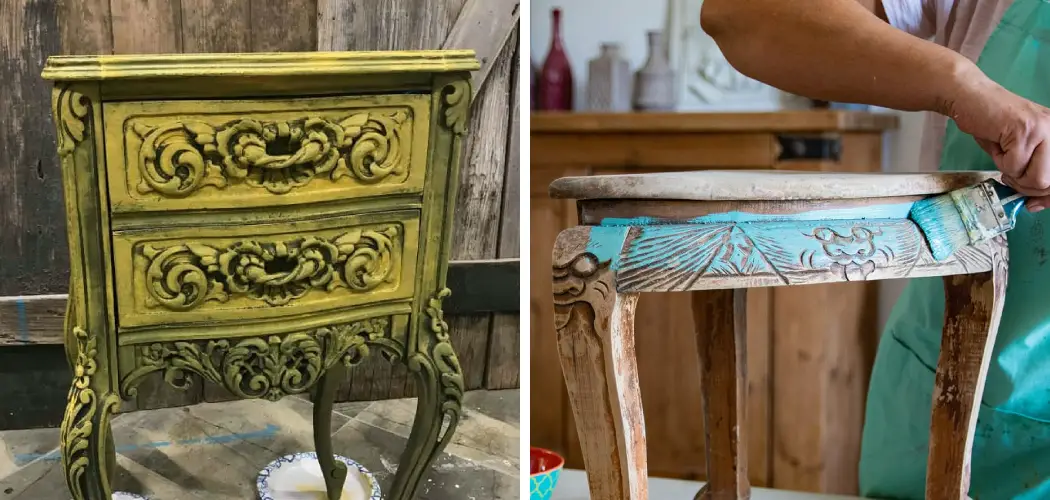Painting carved wood furniture can be a fun and rewarding project, especially if you have a creative side. Whether you want to add some color to an old piece of furniture or give it a completely new look, painting is a great option. However, before jumping into the painting process, it’s important to understand the steps involved and how to properly prepare your furniture for painting. In this guide on how to paint carved wood furniture, we’ll go through the necessary steps to achieve a professional-looking finish.
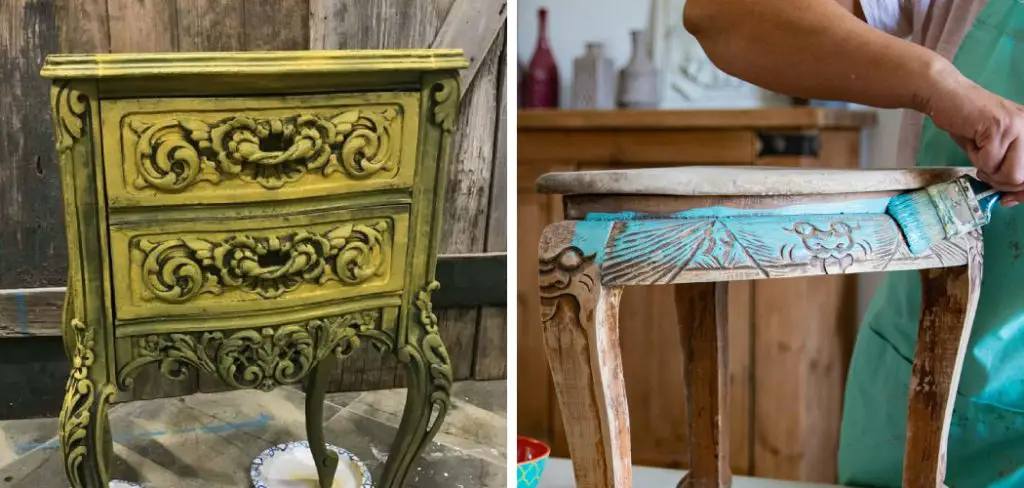
Necessary Items
Before you begin painting, gather all the necessary items you will need to complete this project. This includes:
- Sandpaper (medium grit)
- Primer
- Paintbrushes (various sizes)
- Acrylic or latex paint in the desired color(s)
- Polyurethane sealer
- Clean cloth or rag
- Drop cloth or newspaper
10 Signs You’re Ready to Paint Carved Wood Furniture
1. The Furniture is in Good Condition
Before painting, check for any damages or repairs that need to be made. If the furniture is in poor condition, it may not be suitable for painting. If there are any broken or missing pieces, it’s important to fix them before proceeding with painting.
2. The Surface is Clean
Make sure the furniture is free of dust, dirt, and grime before starting the painting process. Use a clean cloth or rag to wipe down the surface and remove any debris. If the furniture has been previously painted, make sure to remove any flaking or chipping paint.
3. The Furniture is Fully Dry
If you have recently cleaned the furniture, make sure it is completely dry before starting to paint. Any moisture can affect the quality of the paint and may lead to an uneven finish. However, if your furniture has been in storage for a while, it’s always a good idea to wipe it down with a damp cloth and allow it to dry before painting.

4. You Have Proper Ventilation
Painting can release strong fumes and chemicals, so make sure you have proper ventilation when working on your project. This could be an open window or door or even using a fan to circulate fresh air.
5. You Have Enough Space
Make sure you have enough space to comfortably work on your project. If possible, it’s best to paint in a well-ventilated area such as a garage or outdoor space. This will allow for easier movement and prevent any accidental spills or damage to other items in your home.
6. You Have Enough Time
Painting can be a time-consuming process, especially when working with carved wood furniture. Make sure you have enough time set aside to complete the project without feeling rushed. This will ensure that you are able to give each step the attention and care it needs for a successful outcome.
7. You Have All Necessary Materials
As mentioned earlier, make sure you have all the necessary materials before starting to paint. This will prevent any unnecessary trips to the store and ensure a smooth painting process. As a bonus, having all materials on hand will also allow for any touch-ups or fixes that may be needed later on.
8. You Have a Plan for the Design
If you’re going for a specific design or pattern, it’s important to have a plan before starting to paint. This could include sketches or reference images to guide your painting process and ensure a cohesive final look.
9. You’ve Practiced on a Test Piece
If you’re new to painting furniture, it’s always a good idea to practice on a small test piece before tackling your main project. This will allow you to get familiar with the tools and techniques needed for painting carved wood furniture.
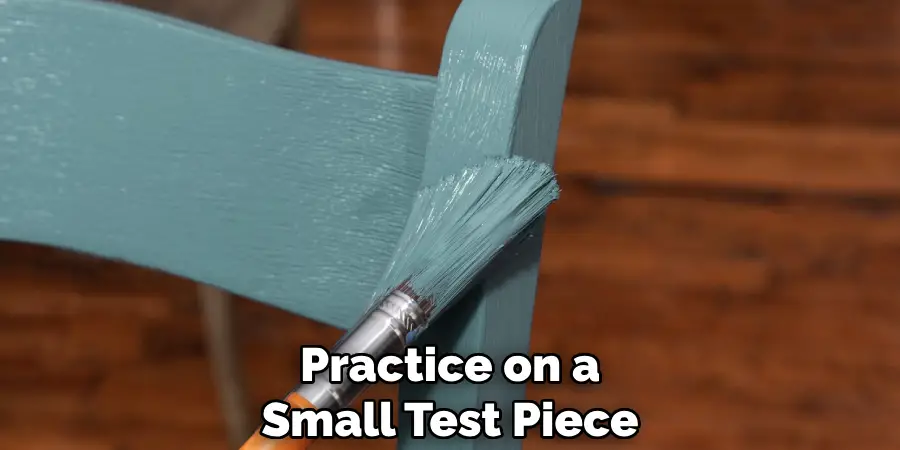
10. You’re Excited and Ready to Get Creative
Painting furniture is a fun and creative process, so make sure you’re in the right mindset before starting. Put on some music, get inspired, and let your creativity flow as you transform your carved wood furniture into a work of art!
Painting carved wood furniture can be a challenging yet rewarding project. By following these steps on how to paint carved wood furniture and taking the time to properly prepare and plan your project, you can achieve a professional-looking finish that will bring new life to your furniture. So gather your materials, get creative, and enjoy the process of painting your carved wood furniture! Remember to have fun, and don’t be afraid to experiment with different colors and techniques.
12 Steps on How to Paint Carved Wood Furniture
Step 1: Choose the Right Paint and Tools
Before you can start painting your carved wood furniture, you need to make sure that you have all the necessary tools and materials. The type of paint you choose will depend on your personal preference and the look you’re trying to achieve. Acrylic or latex paint are good options for beginners as they are easy to work with and provide a smooth finish.
Step 2: Prepare the Furniture
Before starting to paint, it’s important to prepare the furniture by sanding down any rough or uneven areas. This will create a smooth surface for the paint to adhere to. Use medium grit sandpaper, and be sure to wipe down the furniture afterward to remove any dust.
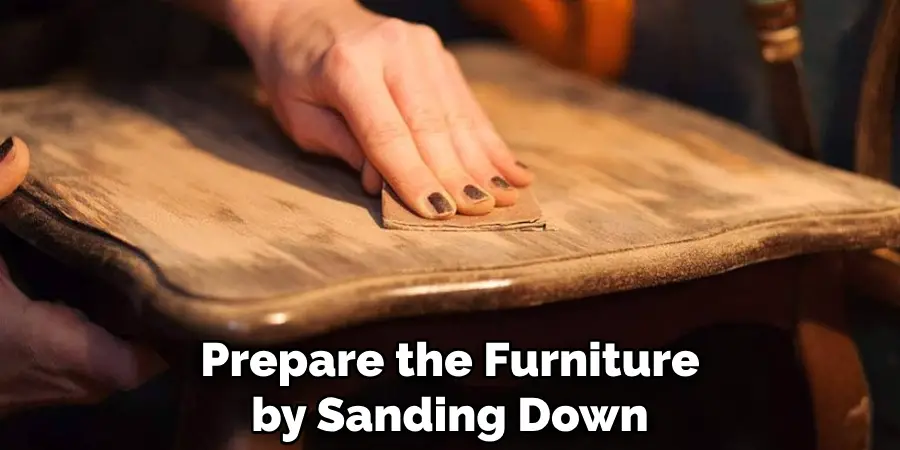
Step 3: Apply Primer
Primer is an important step in painting carved wood furniture, as it helps the paint adhere better and provides a smoother finish. Use a small brush to apply primer to all areas of the furniture, making sure to cover any intricate carvings or details.
Step 4: Let the Primer Dry
Allow the primer to fully dry before proceeding with painting. This can take anywhere from a few hours to overnight, depending on the type of primer used and the climate you’re working in. It’s important not to rush this step as it will affect the overall quality of your paint job.
Step 5: Choose Your Paint Colors
Now comes the fun part – choosing your paint colors! It’s best to have a plan in place before starting, but don’t be afraid to get creative and mix different colors for a unique look. You can also use multiple shades of the same color to add dimension and depth to your furniture.
Step 6: Start Painting!
Using a small brush, start painting the furniture with your chosen color(s). Be sure to cover all surfaces evenly and apply multiple coats as needed for a smooth and consistent finish. You may also choose to use a paint sprayer or roller for larger surfaces.
Step 7: Paint in Sections
If your furniture has intricate carvings or details, it’s best to paint in small sections to ensure an even and thorough coverage. This may take longer, but it will result in a more professional-looking finish. And remember, don’t rush – take your time and enjoy the process!
Step 8: Allow Paint to Dry
Once you have finished painting, allow the furniture to dry completely before proceeding. This can take several hours, so make sure you have enough time set aside for this step. If you’re using multiple colors, make sure to let each one dry before moving on to the next.
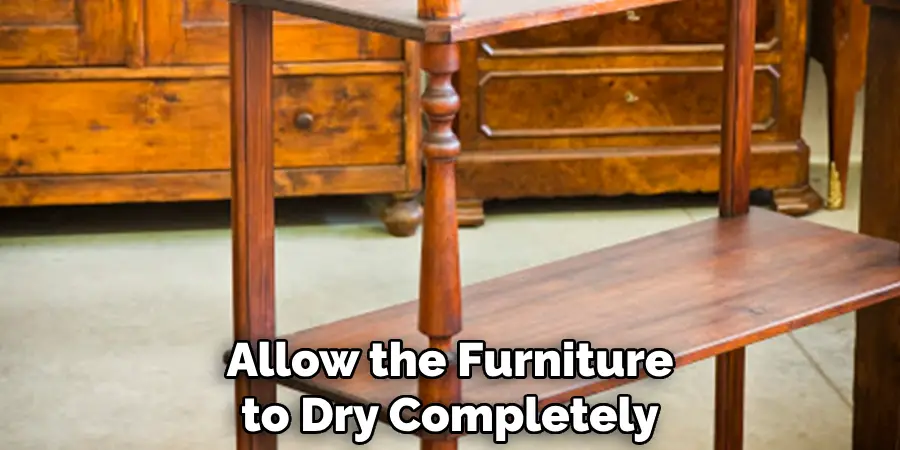
Step 9: Sand Between Coats
If you’re applying multiple coats of paint, it’s important to lightly sand between each coat. This will help create a smoother surface and prevent any visible brush strokes or uneven areas. Use fine-grit sandpaper and be gentle to avoid damaging the paint.
Step 10: Seal with a Clear Coat
To protect your painted carved wood furniture and give it a professional-looking finish, apply a clear coat sealer once the paint is fully dry. This will also make the furniture more durable and easier to clean in the future. Use a small brush or roller to evenly apply the sealer.
Step 11: Allow Sealer to Dry
Just like with the paint, it’s important to let the sealer fully dry before using or moving the furniture. This can take a few hours to overnight, depending on the type of sealer used. Avoid touching or placing anything on the furniture until it is completely dry.
Step 12: Enjoy Your Newly Painted Furniture!
Congratulations, you’ve successfully painted your carved wood furniture! Take a step back and admire your hard work – you now have a beautiful piece of furniture that reflects your personal style and creativity. Don’t be afraid to show it off and enjoy the new look in your home! Remember to properly care for your painted furniture by avoiding harsh chemicals or abrasive cleaners, and it will continue to look beautiful for years to come.
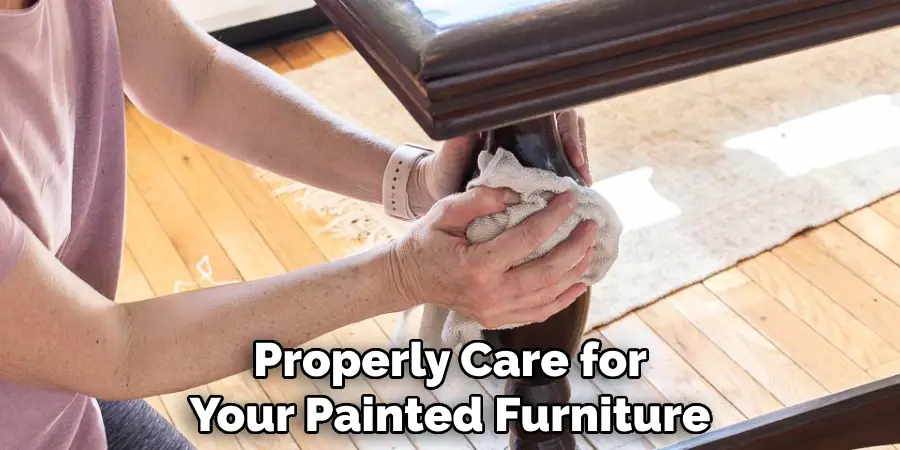
8 Things to Avoid When Painting Carved Wood Furniture
1. Not Sanding the Surface Properly
Skipping the sanding step or not doing it thoroughly can result in a rough and uneven surface, making it difficult for paint to adhere properly. But don’t worry, sanding doesn’t have to be a long and tedious process – just make sure to take your time and do it properly.
2. Using the Wrong Type of Paint
Using the wrong type of paint can result in a less than desirable finish. Make sure to choose a paint that is suitable for wood surfaces and provides good coverage and durability. Acrylic or latex paint are good options for beginners, but make sure to do your research and choose the best type of paint for your project.
3. Rushing the Drying Process
It’s important to allow each layer of paint and sealer to fully dry before moving on to the next step. Rushing this process can result in a tacky finish or damage to the paint. Be patient and give your furniture enough time to dry properly.
4. Not Protecting Your Work Area
Painting can be messy, so make sure to protect your work area with drop cloths or newspapers to avoid getting paint on any surfaces you don’t want it on. Also, wear appropriate clothing and gloves to protect yourself from any potential drips or spills.

5. Forgetting to Prime
Primer is an essential step in painting carved wood furniture, as it helps the paint adhere better and provides a smoother finish. Skipping this step can result in uneven coverage and a less durable paint job.
6. Using Too Much Paint
When it comes to painting furniture, less is often more. Applying too much paint can result in a thick and uneven finish, as well as longer drying times. It’s better to do multiple thin coats of paint for a smoother and more professional-looking finish.
7. Not Painting in a Well-Ventilated Area
It’s important to have proper ventilation when painting, as the fumes from paint and sealer can be harmful if inhaled. Make sure to work in a well-ventilated area, such as outdoors or with windows and doors open.
8. Neglecting to Clean Your Tools
Properly cleaning your paintbrushes and other tools after use is important for their longevity and maintaining the quality of your future projects. Using warm water and soap, thoroughly wash all tools used for painting and allow them to dry completely before storing. This will also prevent any paint from drying on the brushes, making them easier to clean in the future. By avoiding these common mistakes, you can ensure a successful and beautiful paint job on your carved wood furniture.
8 Additional Tips for Painting Carved Wood Furniture
1. Test the Paint Color First
Before committing to painting your entire piece of furniture, it’s a good idea to test the paint color on a small, inconspicuous area first. This will give you an idea of how the color will look when fully applied and allow you to make any necessary adjustments.
2. Use a Drop Cloth to Catch Drips
To avoid any paint drips from landing on your floors or other surfaces, use a drop cloth or old sheet underneath the furniture while painting. This will also make for an easier cleanup afterward. But make sure to secure the drop cloth in place to avoid any accidents.
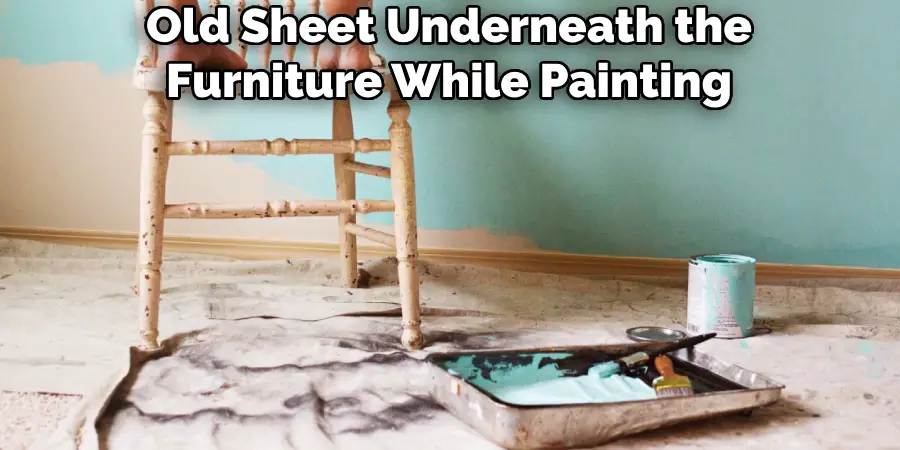
3. Use a Paintbrush with Natural Bristles
When painting carved wood furniture, it’s best to use a paintbrush with natural bristles as they are softer and more flexible, making them better for getting into crevices and intricate details. And remember to choose a brush size appropriate for the size of your furniture and the areas you are painting.
4. Sand in Between Coats
In addition to sanding between coats, it’s also helpful to lightly sand the surface before applying the first coat of paint. This will help create an even smoother finish and better adhesion for the paint. If necessary, use fine-grit sandpaper to avoid scratching the wood.
5. Use Tape for Clean Edges
If you want clean and precise edges on your painted furniture, use painter’s tape to create straight lines and protect other areas from paint splatters. Make sure to press down firmly on the tape before painting to prevent any bleeding of paint underneath.
6. Try Painting in Layers
For a unique and textured look, try painting your carved wood furniture in layers of different colors. This can create a distressed or vintage effect that adds character to your piece. So, don’t be afraid to experiment with different colors and techniques.
7. Use a Sealant for Added Protection
To ensure your painted furniture stays looking beautiful for years to come, consider using a sealant on top of the paint. This will provide added protection against scratches and wear, as well as make it easier to clean in the future.
8. Have Fun and Be Creative
Painting furniture is a fun and creative way to personalize your home decor. Don’t be afraid to let your imagination run wild and try new techniques and colors. Remember, it’s just paint – you can always sand it down and start over if you’re not happy with the result. Enjoy the process and have fun creating a unique piece of furniture for your home. So go ahead and give painting your carved wood furniture a try – with the right tools, techniques on how to paint carved wood furniture, and patience, you can transform any piece into a work of art.

Frequently Asked Questions
Can I Paint Over an Already Painted Piece of Carved Wood Furniture?
Yes, you can paint over a previously painted piece of carved wood furniture. Just make sure to properly clean and sand the surface before applying a new coat of paint. If there are any chips or peeling paint, make sure to fix those areas before painting.
Do I Need to Use a Primer Before Painting?
While it’s not always necessary, using a primer can help ensure better adhesion and coverage of the paint. It also helps create a smoother finish and can prevent stains from bleeding through the paint. For best results, use a primer specifically designed for wooden surfaces.
Can I Use Any Type of Paint on Carved Wood Furniture?
It’s important to use a paint that is suitable for wood surfaces, such as latex or acrylic paint. Avoid using oil-based paints as they can take longer to dry and may not provide the best coverage. Also, make sure to choose a finish that suits your desired look and level of durability.
Should I Seal my Painted Carved Wood Furniture?
Using a sealant on top of the paint is recommended for added protection and longevity of the finish. This is especially important if the furniture will be used frequently or exposed to moisture. Choose a sealant specifically made for painted wood surfaces and follow the instructions for best results. Remember, proper preparation and technique are key to achieving a successful and professional-looking paint job on your carved wood furniture.
Conclusion
We hope this guide has provided helpful tips and information for painting carved wood furniture. By avoiding common mistakes, properly preparing the surface, using the right tools and techniques on how to paint carved wood furniture, and having fun with creativity, you can transform any piece into a unique and beautiful addition to your home. Remember to always work in a well-ventilated area, properly clean and care for your tools, and have patience for the best results.
So don’t be afraid to take on this DIY project and add some personality to your furniture. With these additional tips, you can confidently tackle any painting project and achieve professional-looking results every time. So go ahead and give it a try – with the right tools, techniques, and creativity, you can transform your carved wood furniture into a stunning masterpiece. Keep these tips in mind and have fun with the process – you’ll be amazed at the beautiful results you can achieve!

